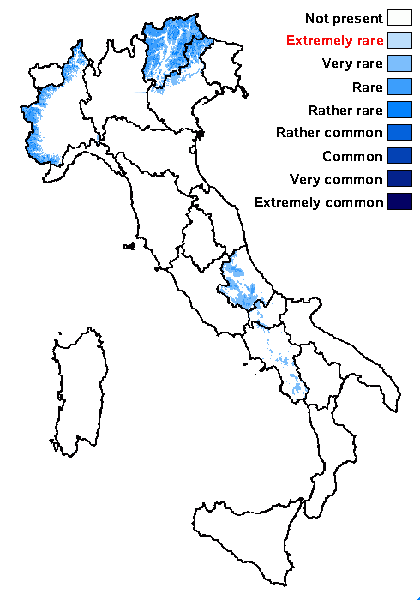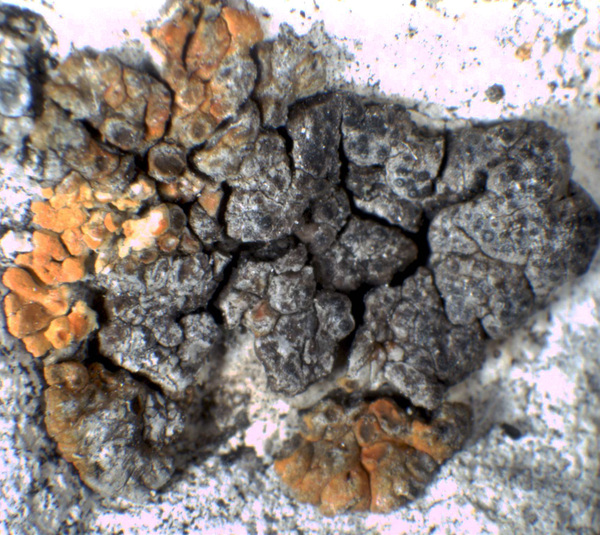Verrucula biatorinaria (Zehetl.) Nav.-Ros. & Cl. Roux
in Navarro-Rosinés & al., Bull. Soc. linn. Provence, 58: 153, 2007. Basionym: Verrucaria biatorinaria Zehetl. - Nova Hedwigia, 29: 721, 1978.
Synonyms:
Distribution: N - Ven (Navarro-Rosinés & al. 2007), TAA, Piem (TSB 34037). C - Abr (Nimis & Tretiach 1999, Gheza & al. 2021), Mol (Nimis & Tretiach 1999, Caporale & al. 2008). S - Camp (Aprile & al. 2003b).
Description: Thallus crustose, areolate-subsquamulose or verrucose-areolate, forming 3-20(-30) mm wide patches on the thalli of Calogaya biatorina. Areoles crowded, rounded or irregularly polygonal, (0.3-)0.6-1.6(-2) mm wide, 0.4-0.8 mm thick, flat to convex, attached by the central part and sometimes substipitate, grey brown with black margins and lower surface. Cortex 8-15 µm thick, of 1-3 layers of pale brown cells, rarely covered with a thin, discontinuous epinecral layer; medulla white, dense, filled by crystals and substrate particles, I-. Perithecia black, 0.15-0.3 mm across, globose, immersed in the areoles. Involucrellum absent; exciple 15-20 µm thick, the wall paraplectenchymatous, colourless except around the ostiole; hymenium colourless, I+ reddish; hamathecium of periphyses along the ostiolar channel, pseudoparaphyses in upper part of the perithecium, and paraphyses disappearing early; pseudoparaphyses 18-27 x 2,5-4 μm. Asci 8-spored, clavate, bitunicate, with a thin tholus reacting I-, Verrucaria-type. Ascospores 1-celled, hyaline, ellipsoid, (8.5-)11-13.5(-16) x 6-9.5 μm. Pycnidia black, globose immersed, Dermatocarpon-type, the wall colourless except at the brown apex. Conidia simple, bacilliform, 4.5-6 x 1-1.5 μm. Photobiont chlorococcoid. Spot tests: K-, C-, KC-, P-, UV-. Chemistry: without lichen substances. Note: a lichenicolous lichen growing on the thalli of Calogaya biatorina; certainly more widespread in the Alps and along the Apennines.
Growth form: Crustose
Substrata: rocks
Photobiont: green algae other than Trentepohlia
Reproductive strategy: mainly sexual
paras Calogaya biatorina
Commonnes-rarity: (info)
Alpine belt: rare
Subalpine belt: rather rare
Oromediterranean belt: absent
Montane belt: very rare
Submediterranean belt: absent
Padanian area: absent
Humid submediterranean belt: absent
Humid mediterranean belt: absent
Dry mediterranean belt: absent

Predictive model
Herbarium samples
Growth form: Crustose
Substrata: rocks
Photobiont: green algae other than Trentepohlia
Reproductive strategy: mainly sexual
paras Calogaya biatorina
Commonnes-rarity: (info)
Alpine belt: rare
Subalpine belt: rather rare
Oromediterranean belt: absent
Montane belt: very rare
Submediterranean belt: absent
Padanian area: absent
Humid submediterranean belt: absent
Humid mediterranean belt: absent
Dry mediterranean belt: absent

Predictive model
| Herbarium samples |
 Index Fungorum
Index Fungorum
 GBIF
GBIF





